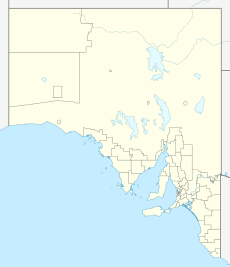geo.wikisort.org - Island
Cap Island Conservation Park is a protected area in the Australian state of South Australia located about 7.5 kilometres (4.7 mi) offshore, west of Mount Misery, Eyre Peninsula. The park covers Cap Island's 8ha surface. The island consists of a granite base and a calcarenite mantle; its margins steeply over-hanging and eroded. Typical vegetation is a low Nitre Bush (Nitraria billardierei) shrubland. Cap Island Conservation Park was constituted by statute in 1972 to conserve a sea bird breeding area and Australian Sea-lion (Neophoca cinerea) and New Zealand Fur-seal (Arctocephalus forsteri) haul-out areas.[3]
| Cap Island Conservation Park South Australia | |
|---|---|
IUCN category Ia (strict nature reserve)[1] | |
 Cap Island Conservation Park | |
| Nearest town or city | Elliston. |
| Coordinates | 33°56′42.51″S 135°7′6.73″E |
| Established | 16 March 1967[2] |
| Area | 9 hectares (22 acres)[2] |
| Managing authorities | Department for Environment and Water |
| See also | Protected areas of South Australia |
Cap Island also bears the alternative name of Gap Island and historically was also known as Rocky Island.[4]
History
Matthew Flinders named the island on 16 February 1802, alluding to the island's topography, geology and cap-like profile. The island was proclaimed a Fauna Conservation Reserve in 1967.[5] and gazetted as the Cap Island Conservation Park in 1972. The conservation park is classified as an IUCN Category Ia protected area.[6]
Fauna
In addition to marine mammals, at least nine species of birds have been recorded on Cap Island.[7] These include:
- Chroicocephalus novaehollandiae: Silver Gull
- Haematopus fuliginosus fuliginosus: Sooty Oystercatcher
- Hirundo (Hirundo) neoxena neoxena: Welcome Swallow
- Neophema (Neonanodes) petrophila: Rock Parrot
- Pelagodroma marina: White-faced Storm-petrel
- Sterna (Sterna) striata: White-fronted Tern
- Sternula nereis nereis: Fairy Tern
- Sturnus (Sturnus) vulgaris vulgaris: Common Starling
- Thalasseus bergii: Crested Tern
Flora
At least eight species of plants have been recorded on Cap Island.[7] They include:
- Apium prostratum var. prostratum: Sea Celery
- Disphyma crassifolium subsp. clavellatum: Rounded Noon-flower
- Frankenia pauciflora var. fruticulosa
- Frankenia pauciflora: Australian Sea-heath
- Lawrencia squamata: Thorny Lawrencia
- Mesembryanthemum crystallinum: Common Ice plant
- Nitraria billardierei: Dillon Bush
- Zygophyllum apiculatum: Callweed
References
- "Terrestrial Protected Areas of South Australia (refer 'DETAIL' tab )". CAPAD 2016. Australian Government, Department of the Environment (DoE). 2016. Retrieved 21 February 2018.
- "Protected Areas Information System - reserve list (as of 25 November 2014)" (PDF). Department of Environment Water and Natural Resources. Retrieved 8 January 2015.
- Management Plan - Island Parks of Western Eyre Peninsula. South Australia: Government of South Australia - Department for Environment & Heritage. 2006. ISBN 1 921238 18 6.
- "Search results for 'Cap Island, Is' with the following datasets selected - 'Gazetteer'". Location SA Map viewer. South Australian government. Retrieved 6 February 2018.
- "CROWN LANDS ACT, 1929-1966: FAUNA CONSERVATION RESERVES DEDICATED" (PDF). THE SOUTH AUSTRALIAN GOVERNMENT GAZETTE. Government of South Australia. 16 March 1967. pp. 961–962. Retrieved 5 February 2018.
- "Terrestrial Protected Areas of South Australia (see 'DETAIL' tab)". CAPAD 2012. Australian Government - Department of the Environment. 6 February 2014. Retrieved 6 February 2014.
- "Explore Your Area - Cap Island, South Australia". The Atlas of Living Australia. Retrieved 30 August 2014.
External links
Другой контент может иметь иную лицензию. Перед использованием материалов сайта WikiSort.org внимательно изучите правила лицензирования конкретных элементов наполнения сайта.
WikiSort.org - проект по пересортировке и дополнению контента Википедии